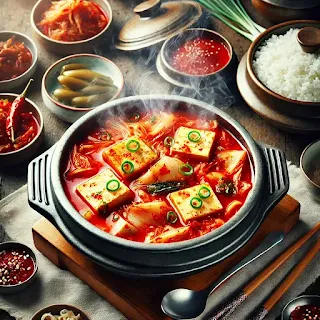Kimchi Jjigae, or kimchi stew, is a beloved Korean dish that combines the rich flavors of fermented kimchi with hearty ingredients. Perfect for chilly days or when you're in need of a comforting meal, this dish has stood the test of time as one of Korea's most iconic comfort foods. In this article, we’ll explore its history, ingredients, variations, and a simple recipe you can try at home.
📋 Table of Contents
The History of Kimchi Jjigae
Kimchi Jjigae has its roots in traditional Korean home cooking. It originated as a way to use over-fermented kimchi, ensuring no food went to waste.
During Korea's agricultural era, families would create stews using available ingredients, and kimchi, being a staple, naturally found its way into these dishes.
Over time, this humble dish evolved into a favorite comfort food, loved for its bold flavors and simplicity.
Kimchi Jjigae is deeply tied to Korean culture and represents the resilience and creativity of its people.
Today, it is not only served at home but also in restaurants, showcasing its universal appeal.
Despite its variations, the dish remains an iconic representation of Korean cuisine's hearty and spicy flavors.
Whether enjoyed alone or with loved ones, Kimchi Jjigae carries a sense of nostalgia for many Koreans.
Essential Ingredients
The key to a delicious Kimchi Jjigae lies in its ingredients. Here's what you'll need:
1. **Kimchi**: Preferably aged, as the tangy and robust flavor enhances the stew.
2. **Pork or Tofu**: Pork belly is a popular choice, but tofu makes it vegetarian-friendly.
3. **Onion and Garlic**: These add depth and aroma to the dish.
4. **Gochugaru (Korean chili flakes)**: For that spicy kick.
5. **Doenjang (soybean paste)**: Optional but adds a layer of umami.
6. **Stock or Water**: Anchovy stock is traditional, but vegetable or chicken stock works too.
These simple yet flavorful ingredients form the foundation of Kimchi Jjigae.
How to Make Kimchi Jjigae
Making Kimchi Jjigae is simple and straightforward. Here's a step-by-step guide:
1. **Prepare Ingredients**: Slice kimchi, pork (or tofu), onions, and garlic.
2. **Sauté**: In a pot, heat sesame oil and sauté garlic and onions until fragrant.
3. **Add Kimchi and Meat**: Stir-fry aged kimchi and pork until lightly browned.
4. **Simmer**: Add stock or water, gochugaru, and optional doenjang. Bring to a boil, then simmer.
5. **Final Touches**: Add tofu and simmer for an additional 10 minutes.
6. **Serve**: Garnish with green onions and enjoy with steamed rice.
This hearty stew is best enjoyed piping hot!
Regional Variations
Different regions in Korea add their own unique spin to Kimchi Jjigae:
1. **Seoul Style**: Focuses on simplicity with a mild flavor profile.
2. **Jeolla Province**: Known for adding seafood like clams or shrimp for added depth.
3. **Gangwon Province**: Incorporates potatoes for a heartier stew.
4. **Gyeongsang Province**: Uses more gochugaru for a spicier kick.
These variations showcase the diversity of Korean cuisine while maintaining the dish's essence.
Experimenting with regional styles can add excitement to your cooking!
No matter the variation, Kimchi Jjigae always delivers a comforting and satisfying meal.
What to Pair with Kimchi Jjigae
Kimchi Jjigae pairs wonderfully with various Korean side dishes and accompaniments:
1. **Steamed Rice**: The perfect complement to soak up the flavors.
2. **Banchan (Side Dishes)**: Pickled radish, spinach, or seasoned bean sprouts.
3. **Grilled Fish**: Adds a savory balance to the meal.
4. **Korean Pancakes (Jeon)**: Crispy and savory pancakes pair beautifully with the stew.
5. **Makgeolli (Rice Wine)**: A traditional Korean drink to enjoy alongside your meal.
Pairing these dishes enhances the overall dining experience and creates a satisfying meal.
Health Benefits of Kimchi Jjigae
Kimchi Jjigae is not only delicious but also nutritious. Here's why:
1. **Rich in Probiotics**: Kimchi contains live cultures that support gut health.
2. **Low in Calories**: A healthy option for those watching their weight.
3. **Packed with Vitamins**: Kimchi is a good source of vitamin C and K.
4. **High in Protein**: Adding tofu or pork increases protein intake.
5. **Boosts Immunity**: Fermented foods are known to strengthen the immune system.
Kimchi Jjigae is the perfect combination of flavor and health benefits.
FAQ About Kimchi Jjigae
What type of kimchi is best for Kimchi Jjigae?
Aged kimchi is ideal as it has a tangy and deep flavor that enhances the stew.
Can I make Kimchi Jjigae without meat?
Yes, substitute pork with tofu or mushrooms for a vegetarian version.
Is Kimchi Jjigae spicy?
It can be spicy, but you can adjust the spice level by reducing gochugaru (Korean chili flakes).
What kind of stock is best for Kimchi Jjigae?
Anchovy stock is traditional, but you can use vegetable, chicken, or even plain water.
Can I freeze leftover Kimchi Jjigae?
Yes, it freezes well. Just reheat thoroughly before serving.
How long does it take to make Kimchi Jjigae?
It usually takes about 30-40 minutes from preparation to serving.
Can I add other vegetables to Kimchi Jjigae?
Absolutely! Mushrooms, zucchini, or green onions are great additions.
What side dishes go well with Kimchi Jjigae?
Steamed rice, banchan, and grilled fish are perfect accompaniments.

